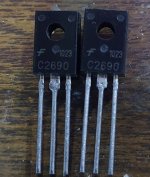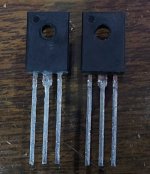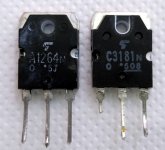Cool, thx!I dont know if it's OT, but here is a very good website about transistor dies:
https://www.richis-lab.de/
Or Copy
Many times you can't tell without running electrical tests these days. So if you can't, then ...
Simple. Buy from known good sources, the first choices being authorized distributors. I assume devices are fake these days until I prove they are legit. The cost of doing this normally moves the idea of a "deal" into not worthwhile. One cheap copy or fake can take out $$$ worth of real good devices and a great deal of time and effort. Is that really worth it?
Simple. Buy from known good sources, the first choices being authorized distributors. I assume devices are fake these days until I prove they are legit. The cost of doing this normally moves the idea of a "deal" into not worthwhile. One cheap copy or fake can take out $$$ worth of real good devices and a great deal of time and effort. Is that really worth it?
2SA1264 2SC3181 Toshiba fakes. Replacements in a broken channel L-405 Luxman amp. Came for a test. Hfe alright, power output compared alright, THD compared alright. How did I know they aren't real? Simply, slower. Original channel 150kHz F3, repaired channel with these 50kHz. Rounded edge somewhat crooked square wave.
After a pair of original green and black era Toshibas were luckily found at an old technician's shop, proper F3 and square wave shape returned.
After a pair of original green and black era Toshibas were luckily found at an old technician's shop, proper F3 and square wave shape returned.
Attachments
Wow!
Those were pretty bad. I suspect new Chinese manufacture. Other transistors from that era were not nearly that slow!
-Chris
Those were pretty bad. I suspect new Chinese manufacture. Other transistors from that era were not nearly that slow!
-Chris
They were bought from a big electronics shop locally by the amp's owner who installed them but they didn't pass the speed test when he brought it over. They were hesitant to call them originals at the shop even!
At least they biased normally and honored 100W unclipped output at 8Ω. More than what a Luxman L-405 claimed in the 80s but the mains are 10VAC higher since then here. Power result and FFT behavior looked the same as in the other channel fitted with the original transistors.
Same 0.02% THD at 100W. To finally reach 1% THD at 115W. 1% is roughly the level of visual clip onset on a scope's sinewave.
I suspect a general use proper size but slow die inside like a 2N3055 or something. I could measure the Hfe because he had two spares also. And it was in spec strong for their O suffix. PNP beta being stronger than in NPN was a common trend across copies and the finally found R suffix green/black big T logo original replacements.
At least they biased normally and honored 100W unclipped output at 8Ω. More than what a Luxman L-405 claimed in the 80s but the mains are 10VAC higher since then here. Power result and FFT behavior looked the same as in the other channel fitted with the original transistors.
Same 0.02% THD at 100W. To finally reach 1% THD at 115W. 1% is roughly the level of visual clip onset on a scope's sinewave.
I suspect a general use proper size but slow die inside like a 2N3055 or something. I could measure the Hfe because he had two spares also. And it was in spec strong for their O suffix. PNP beta being stronger than in NPN was a common trend across copies and the finally found R suffix green/black big T logo original replacements.
There are Chinese foundries making new parts using the original numbers these days. The die and everything is new manufacture. They claim new, original parts. This is true in one sense, but a total lie considering that in the Japanese system, only one manufacturer can make a part number. Even an identicle part from a competing manufacturer must have it's own registered number in the JIS system.
I would call them fakes. The entire industry should be united in this as they do not adhere to teh original specifications, and even if they did they are not made by the OEM. They could, however, change the prefix as they did in Korea (ie KSA970), which would then be clear and fair game.
I use new, current parts only. With the exception of old transistors which I have, or from other people I know for certain are original stock. The other exceptions are specialized ICs which you can find out there, but I have had a terrible time with fakes (they don't even work) for parts like uPC1225H and uPC1270H. Three batches, three suppliers - all fake, every one. They had good markings too!
I would call them fakes. The entire industry should be united in this as they do not adhere to teh original specifications, and even if they did they are not made by the OEM. They could, however, change the prefix as they did in Korea (ie KSA970), which would then be clear and fair game.
I use new, current parts only. With the exception of old transistors which I have, or from other people I know for certain are original stock. The other exceptions are specialized ICs which you can find out there, but I have had a terrible time with fakes (they don't even work) for parts like uPC1225H and uPC1270H. Three batches, three suppliers - all fake, every one. They had good markings too!
He also found ISC 1265/3182 in another local shop with thicker metal back and no side notches cases. But he preferred to install the old tech's stash Toshibas so I didn't get a chance to test the ISC performance. Indian made the seller said. A company like CDIL India maybe OEMs stuff for others, or ISC also has facilities outside China, or he simply mixed brands origin.
That's entirely possible.
It is the "wild, wild west" out there! Referencing the early history of the USA where it was lawless. Basically you cannot trust anything, and even if it looks real is it worth the extensive testing to prove it is?
In the end I only will buy currently manufactured parts from authorized distributors. My name goes on a repair, and the cost of one fake part can take out a bunch of other stuff. It simply is not worth taking a chance. Do you need any more reasons to do it right, do it clean? I'm not talking to you Salas, but others out there need to "get it".
-Chris
It is the "wild, wild west" out there! Referencing the early history of the USA where it was lawless. Basically you cannot trust anything, and even if it looks real is it worth the extensive testing to prove it is?
In the end I only will buy currently manufactured parts from authorized distributors. My name goes on a repair, and the cost of one fake part can take out a bunch of other stuff. It simply is not worth taking a chance. Do you need any more reasons to do it right, do it clean? I'm not talking to you Salas, but others out there need to "get it".
-Chris
Wasn't my repair. I only tested it. If it was mine I would have used current types of possibly ON transistors with alike Ft to the originals. Both in the broken and working channel to match.
No, I get it.
I would not replace the good channel There is no point in that. A customer would never hear the difference and measured performance shouldn't vary much at audio frequencies.
I would not replace the good channel There is no point in that. A customer would never hear the difference and measured performance shouldn't vary much at audio frequencies.
The ones who open up the case want the channels visually matched for parts type. Usually not minding extra parts expense.
That has nothing to do with service, so I'll leave it alone. I would never even suggest it to anyone and if they ask I always explain that it isn't required or beneficial to them. I will if they push the issue, but what a waste!
It isn't just the parts, it's the labour time to remove, clean things up, install, then set bias. Setting bias can take over an hour if it drifts around a lot as in some amplifiers.
It isn't just the parts, it's the labour time to remove, clean things up, install, then set bias. Setting bias can take over an hour if it drifts around a lot as in some amplifiers.
Hello again.
I have managed to find pairs of MJ4238/4248 as replacement for MJ150020/21. I found very little info on these transistors, Does anybody have any info on them and can you tell by the pictures are they real and geniune or not? MJ4237/4247 should be the same, just for lover voltage.








Thanks all in advance,
Ivo
I have managed to find pairs of MJ4238/4248 as replacement for MJ150020/21. I found very little info on these transistors, Does anybody have any info on them and can you tell by the pictures are they real and geniune or not? MJ4237/4247 should be the same, just for lover voltage.
Thanks all in advance,
Ivo
The 4248’s don't look like Motorola at all, and the 4238’s are obviously sanded and re-marked.
I think it would be in your bests interests to crack one open and see what's inside. I suspect that horrors may be lurking under the hat. As has been previously mentioned, the marking looks extremely sketchy, and not like any Motorola device I've seen.
Agree with wg-ski. Motorola never marked their parts with the numbers lined up with the plane of the mounting holes, always perpendicular.
The 4248’s have the small glass seals - which Motorola did use, but ONLY with the domed top hat. So those ain‘t Motorolas. When they went to the squared off ones (after 1985) they had the larger glass seals like the “4238’s” have. You can see the scratch and scrub marks on those. Maybe they are Motorola somethings. Just not MJ4238.
Why in the world would one want to use them as MJ15021/22 replacements I don’t know. Unless you’re trying to worship fT. If you do that you’d best not run ‘em as linear amplifiers anywhere near rated voltage. That might have even be what killed off the short-lived 15021 family. They might not have yielded very well to spec. They just couldn’t make a high fT linear amp transistor to save their souls back then. Not until the MJL3281, which they acquired from outside.
Why in the world would one want to use them as MJ15021/22 replacements I don’t know. Unless you’re trying to worship fT. If you do that you’d best not run ‘em as linear amplifiers anywhere near rated voltage. That might have even be what killed off the short-lived 15021 family. They might not have yielded very well to spec. They just couldn’t make a high fT linear amp transistor to save their souls back then. Not until the MJL3281, which they acquired from outside.
Thank you all for replies. I will open one of each and post pictures.
Yours answers are putting me back to beginning of my story where I am looking for driver transistors which was originally pair of MJ15018/19 or MJ15020/21.
If any of you have some of MJ15018/19/20/21 and would like to sell them, please let me know, I need them for two identical amplifiers, which means four pairs.
Ivo
Yours answers are putting me back to beginning of my story where I am looking for driver transistors which was originally pair of MJ15018/19 or MJ15020/21.
If any of you have some of MJ15018/19/20/21 and would like to sell them, please let me know, I need them for two identical amplifiers, which means four pairs.
Ivo
- Home
- Design & Build
- Parts
- My Transistors, original or copy?


